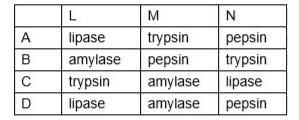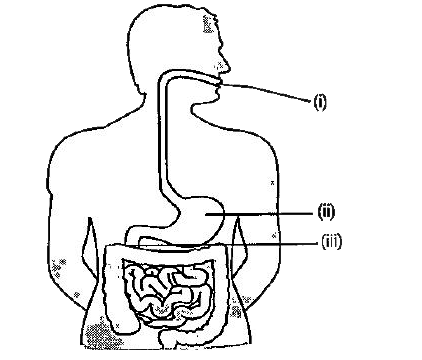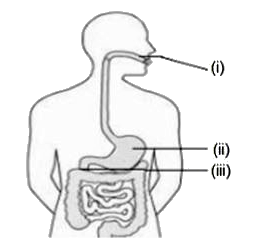Identify the option that indicates the correct enzyme that is secreted in location L, M and N.L, M and N represent Mouth cavity, stomach and small intestine of the human being.

Step by step video & image solution for Identify the option that indicates the correct enzyme that is secreted in location L, M and N.L, M and N represent Mouth cavity, stomach and small intestine of the human being. by Biology experts to help you in doubts & scoring excellent marks in Class 10 exams.
Updated on:21/07/2023Topper's Solved these Questions
- SAMPLE PAPER 2022BOOK - CBSE MODEL PAPERCHAPTER - SAMPLE PAPER 2022EXERCISE - SECTION - B
7 Videos
- Additional Practice QuestionsBOOK - CBSE MODEL PAPERCHAPTER - Additional Practice QuestionsEXERCISE - Question
18 Videos
- SAMPLE PAPER 2022 TERM IIBOOK - CBSE MODEL PAPERCHAPTER - SAMPLE PAPER 2022 TERM IIEXERCISE - SECTION C
2 Videos
Similar Questions
Knowledge Check
Identify the option that indicates the correct enzyme that is secrethed in location (i), (ii) and (iii)
 A(i)-lipase, (ii)-trypsin, (iii)-pepsinB(i)-amylase, (ii) -pepsin, (iii) -trypsinC(i)-trypsin, (ii) -amylase, (iii) -carboxy-laseD(i)-permease, (ii) -carboxylase, (iii) -ox-idase
A(i)-lipase, (ii)-trypsin, (iii)-pepsinB(i)-amylase, (ii) -pepsin, (iii) -trypsinC(i)-trypsin, (ii) -amylase, (iii) -carboxy-laseD(i)-permease, (ii) -carboxylase, (iii) -ox-idaseRead the assertion and reason carefully to mark the correct option out of the option given below:
Assertion: Many tube like glands are present in the wall of small intestine.
Reason : These glands secrete enzymes DNAse and RNAse into the intestinal juice.AIf both the assertion and the reason are true and the reason is a correct explanation of the assertionBIf both the assertion and the reason are true but the reason is a not correct explanation of the assertionCIf the assertion is true but the reason is falseDIf both the assertion and reason are falseIn the human digestive system, digestion occurs in
(a) buccal cavity
(b) stomach
( c) small intestine
(d) large intestine
Chose the correct option from the followingA(a) onlyB(a) and (b) onlyC(b), ( c) and (d) onlyD(a), (b) and ( c) only
If the direction cosines of a straight line are l,mandn,then prove that l2+m2+n2=1.
View Solutioni, ii, iii and iv represent mouth cavity, liver, first part of small intestine and complete small intestine respectively of Human digestive system.
Match the labeling referred in column I andcorrelate with the function in column II.

View SolutionIf l,m,n are the direction cosines of a half line OP then the maximum value of l.m.n is
View SolutionWhich of the following sets of quantum numbers are correct?
n l m n l m
View SolutionIf l,m,n are direction cosines of the line then −l,−m,−n can be
View Solution

